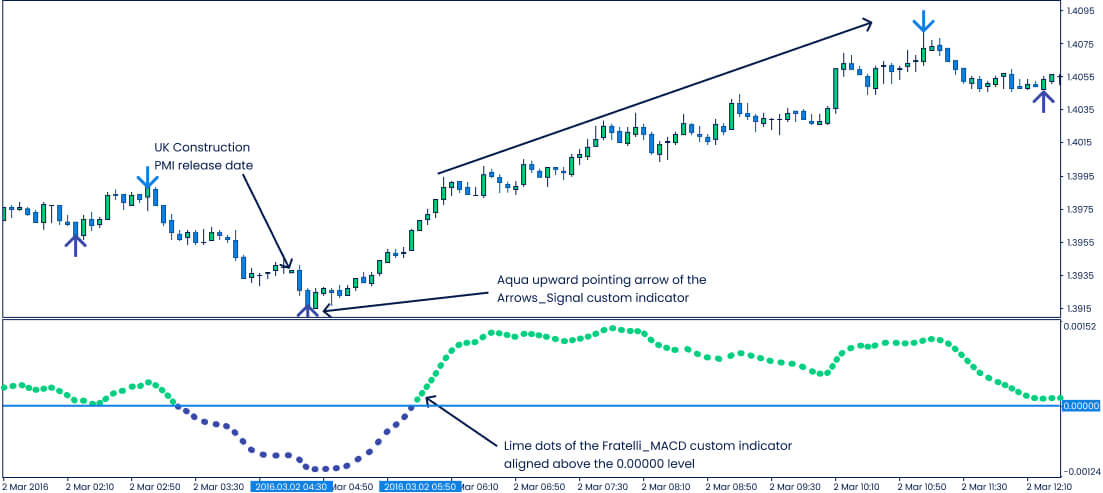The Purchasing Manager's Index (PMI) is an economic indicator providing valuable insights around early economic growth signals. These growth signals directly impact currency values and also help forex traders compare economic performance across different countries to make forex trading decisions.
What is the Purchasing Manager's Index?
The Purchasing Managers' Index (PMI) is a measure of the economic activity in the manufacturing and services sectors of an economy. The index is based on a survey of purchasing managers who are responsible for their company's purchasing activities, production levels, employment, and other factors that can provide insights into the health of sector they represent.
In forex trading, the PMI is an important economic indicator because it can provide insights into the health of an economy and its currency.
- A higher PMI reading typically indicates economic growth and can be a positive signal for a country's currency
- A lower PMI reading suggests economic contraction and can be a negative signal for its currency
Forex traders can monitor the PMI releases to gain insight into the strength of a country's economy and the likely direction of its currency.
For example, if the PMI for a country's manufacturing sector is higher than expected, it could be seen as a sign of increased demand for that country's exports, which could lead to an increase in the value of its currency.
Conversely, if the PMI is lower than expected, it could suggest a slowdown in demand, potentially leading to a decrease in the currency's value.

This graph has been recreated from the original source. Please note this image is a representation only and is not provided as general or personal advice.
How does the Purchasing Manager's Index work?
The Institute for Supply Management (ISM) compiles and releases the Purchasing Managers' Index (PMI) every month. The PMI is based on a survey that is sent every month to senior executives at more than 400 companies in 19 industries that make up a significant portion of the U.S. GDP. The weight of each industry is determined by its contribution to the GDP. The survey measures five main areas: new orders, inventory levels, production, supplier deliveries, and employment, each of which carries equal weight. The surveys inquire about business conditions and whether they are improving, deteriorating, or remaining unchanged.
The PMI is represented by a number from 0 to 100, where a reading above 50 indicates expansion compared to the previous month (demand for goods and services is increasing), signalling traders to place long orders for that country's currency. Whereas a reading below 50 indicates contraction (demand for non-manufacturing industries, such as finance, healthcare, and retail, is decreasing), signalling forex traders to place short orders for that country's currency. A reading of 50 indicates no change.
The PMI can be calculated as: [(P1 x 1) + (P2 x 0.5) + (P3 x 0)]
where,
P1 = Percentage of survey respondents reporting an increase in business activity compared to the previous month
P2 = Percentage of survey respondents reporting no change in business activity compared to the previous month
P3 = Percentage of survey respondents reporting a decrease in business activity compared to the previous month
What key trends and insights can be derived from PMI data?
Currency strength
PMI data provides insights into the relative strength of a country's currency. If a country's PMI reading is higher than that of its trading partners, it could lead to an appreciation of the currency as demand for its goods and services increase. This sends an uptrend signal to traders about the currency and is a bullish market signal. On the other hand, when the PMI reading is lower than that of its trading partners, it could lead to a currency depreciation as demand for its goods and services decrease. This sends a downtrend signal to traders about the currency and is a bearish market signal.
Interest rates
Higher PMI readings suggest an expansion in economic activity, which could lead to higher interest rates. This, in turn, could attract foreign investors seeking higher returns, leading to an appreciation (bullish market behaviour) in the local currency. On the other hand, lower PMI readings suggest a contraction in economic activity leading to lower interest rates. This moves foreign investors away to other countries from a particular country, leading to a depreciation (bearish market behaviour) in the local currency.
Commodity prices
PMI data can impact commodity prices, which can have a significant effect on the currencies of commodity-exporting countries. For example, if the PMI reading in a country that exports oil is higher than expected, it can indicate that the economy is growing, and demand for oil will likely increase. As a result, the price of oil may rise, leading to an increase in revenue for the country that exports it.
The opposite scenario can occur if the PMI reading in a country that exports oil is lower than expected. A lower PMI reading indicates a slowdown in the economy, which can lead to a decrease in demand for oil. As a result, the price of oil may fall, leading to a decrease in revenue for the country that exports it. This fall in commodity prices will lead the currency value of the exporting country to depreciate in value.
Inflation
PMI data can provide insights into inflationary pressures in an economy. Higher (lower) PMI readings suggest an increase (decrease) in demand for goods and services, which could lead to increased (decreased) prices and inflation. In turn, central banks may respond by raising (lowering) interest rates to cool down the economy and contain high (low) inflation. This, in turn, could lead to an appreciation (depreciation) of the local currency, as higher (lower) interest rates will attract (send sway) foreign investment.
Monitor the PMI release to make informed decisions when placing forex orders
PMI data is a valuable tool for forex traders, providing key insights into a country's economic health and potential impact on its local currency.
Forex traders can keep track of the release schedule for PMI data in order to stay informed and make timely trading decisions based on the latest economic trends.
Disclaimer: All material published on our website is intended for informational purposes only and should not be considered personal advice or recommendation. As margin FX/CFDs are highly leveraged products, your gains and losses are magnified, and you could lose substantially more than your initial deposit. Investing in margin FX/CFDs does not give you any entitlements or rights to the underlying assets (e.g. the right to receive dividend payments). CFDs carry a high risk of investment loss.




